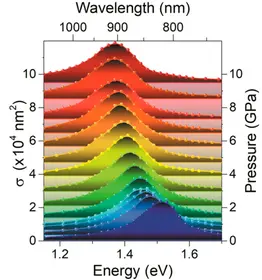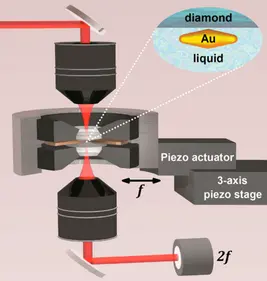M-DAC-XCV-PROXIMA
Membrane - Diamond Anvil Cell
Room temperature.
Spectroscopy at
Medium pressure
Visible - Single crystal - Powder X-ray diffraction - Raman-Infrared
Pressure range*:
- 10 GPa
Temperature range :
- RT to 450K
Optical access to sample :
- Full angle apertures 90°/106°
- Working distance ≥ 10 mm /3.4mm
Sizes :
- Heigh : 26.3 mm (1.01")
- Diameter : Ø 59 mm (2.32")
*(depending on the culet size of the diamonds)
Composed of :
- 2x Conical anvils
- 1x Cover
- 1x Piston
- 1x Cylinder
- 4x Dowels
- 1x Rockers
- 2x Seats
- 4x External adjustment - bridles
DAC body material :
- Inconel
Material of screws and other parts:
- hardened steel
- steel
- stainless steel
Material seats and rocker:
- Inconel
- tungsten carbide - WC
Designed to receive BETSA® Membranes :
- Membrane Cover
Other features: Holes can drilled for access next to the sample to :
-setup Thermocouples
-setup Electrical connectors (electrical measurements)


With small working distance, it allows to use lenses with large numerical apertures and thus to collect a maximum of signal very suitable then for very small samples (even for individual nano-objects as in the article) or samples that give a weak signal.
A collaboration between BETSA® and the UCBL
A NEW "NANO" Membrane Diamond Anvil Cell is available,
to achieve a new objective, a minimal working distance, a lightness and a maximized angular opening.
This NANO MDAC has been developed by the UCBL and now available in partnership sign with BETSA® Company.
Ultra-flat membrane diamond anvil cell
developed for SMS high-pressure experiments.
Pressure range : 0 to 0,1 Mbar (10GPa) (depending on the culet size of the diamonds)
Temperature range : Room temperature to 450 K.
Optical access to sample : Full angle apertures 90°/106°
Working distance 10mm/3,4mm with special optics Mitutoyo Magnification X100.
Objectif M Plan Apo NIR HR 100x
Long distance working lens with a sample located behind a diamond blade (nd = 2.41748) 1.35 mm thick,
Digital aperture: greater than or equal to 0.7 mm
Minimum working distance: 10 mm Resolution: 0.4 μm Weight: 450 g
Accessible electromagnetic spectrum : Visible, X rays, Raman and Infrared (with specific diamonds)
Sizes/Weight : Height 26,3mm (1,01”), Diameter 59mm (2,32”).
2 diamonds conical Ø3,3/85° / WC Cylindrical seat / internal membrane

 ABSTRACT: When reducing the size of a material from bulk down to nanoscale, the enhanced surface-to-volume ratio and the presence of interfaces make the properties of nano-objects very sensitive not only to confinement effects but also to their local environment. In the optical domain, the latter dependence can be exploited to tune the plasmonic response of metal nanoparticles by controlling their surroundings, notably applying high pressures. To date, only a few optical absorption experiments have demonstrated this feasibility, on ensembles of metal nanoparticles in a diamond anvil cell. Here, we report a nontrivial combination between a spatial modulation
ABSTRACT: When reducing the size of a material from bulk down to nanoscale, the enhanced surface-to-volume ratio and the presence of interfaces make the properties of nano-objects very sensitive not only to confinement effects but also to their local environment. In the optical domain, the latter dependence can be exploited to tune the plasmonic response of metal nanoparticles by controlling their surroundings, notably applying high pressures. To date, only a few optical absorption experiments have demonstrated this feasibility, on ensembles of metal nanoparticles in a diamond anvil cell. Here, we report a nontrivial combination between a spatial modulationspectroscopy microscope and an ultraflat diamond anvil cell, allowing us to quantitatively investigate the high-pressure optical extinction spectrum of an individual nano-object. A large tuning of the surface plasmon resonance of a gold nanobipyramid is experimentally demonstrated up to 10 GPa, in quantitative agreement with finite-element simulations and an analytical model disentangling the impact of metal and local environment dielectric modifications. High-pressure optical characterizations of single nanoparticles allow for the accurate investigation and modeling of size, strain, and environment effects on physical properties of nano-objects and also enable fine-tuned applications in nanocomposites, nanoelectromechanical systems, or nanosensing devices.
KEYWORDS: single nanoparticle extinction, spatial modulation spectroscopy, high pressure, diamond anvil cell,
surface plasmon resonance, gold bipyramids

